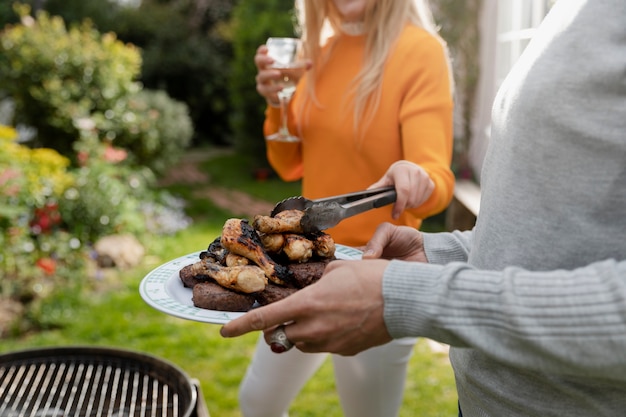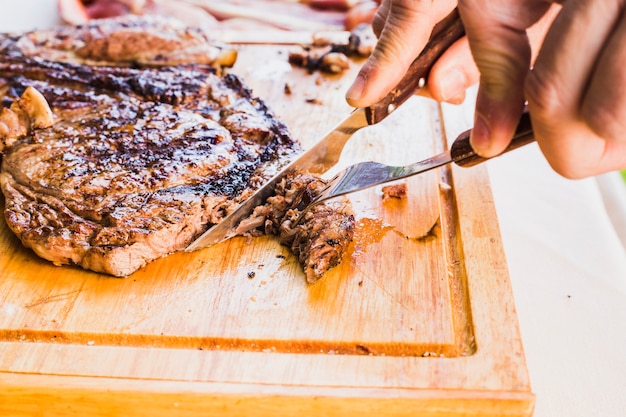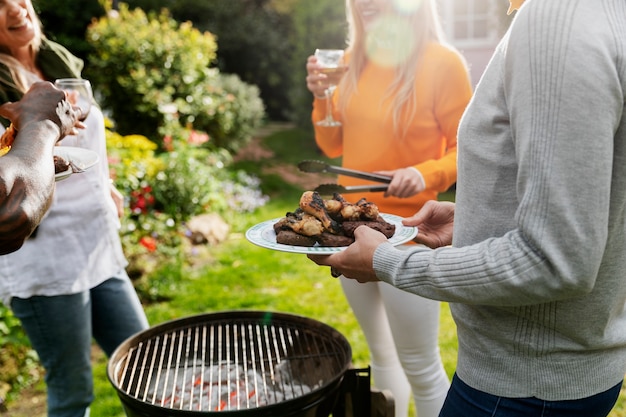Let's talk steak, folks. As someone who's spent a fair bit of time (and devoured countless steaks) perfecting my BBQ skills, I'm here to spill the beans on all my secrets. You don't need to be a seasoned grill master to cook a juicy, flavorful steak. With a little know-how and some practice, you can whip up restaurant-quality steaks right in your backyard, leaving your friends and family impressed. So, grab your tongs, fire up the BBQ, and let's dive in!
(Part 1) The Foundation: Choosing and Prepping

Selecting Your Steak: The Star of the Show
Let's start with the star of the show – the steak itself. The cut you choose will significantly impact your cooking time and the final result. For beginners, I'd recommend cuts that are forgiving and easy to handle – think sirloin, ribeye, or new york strip. These cuts are marbled with fat, which adds flavor and keeps the meat juicy even if you overcook it slightly. If you're feeling adventurous, try a leaner cut like filet mignon or a tenderloin. These cuts demand a bit more attention to avoid drying out. No matter your choice, it's crucial to select a steak that's been properly aged and has good marbling – that's the key to a tender, flavorful steak.
Prepping Your Steak: Getting It Ready for the Grill
Once you've got your steak, it's time to prep it for the grilling glory. The first step is to bring it to room temperature. This might seem like a small detail, but it allows the steak to cook more evenly. So, take it out of the fridge about 30 minutes before you plan to start grilling. While it's warming up, you can give it a pat dry with some paper towels to remove any excess moisture. This helps create a crispy crust during cooking.
Getting Your BBQ Ready: Setting the Stage
Now, let's set the stage for your steak. I'm a huge fan of charcoal grilling for steak – it imparts that smoky flavor that elevates the whole experience. If you're using gas, preheat your grill to medium-high heat (around 400-450°F). This high heat will sear the steak properly, locking in those juicy flavors. For charcoal, build a good bed of hot coals, spread evenly across your grill. Remember, we're aiming for direct heat here, so the steak sits right over the fire.
(Part 2) The Science of steak temperatures: Understanding Doneness

internal temperature: Your Steak's Secret Code
Let's get real – the key to a perfect steak is hitting the right internal temperature. Don't rely on your eyes alone; use a reliable meat thermometer. I've learned the hard way that a steak can look perfectly cooked but still be raw inside. A good thermometer provides accurate readings and ensures your steak is cooked to your exact preference.
The Doneness Chart: Decoding Your Steak's Preferences
Here's a quick chart to break down the different levels of doneness and their corresponding internal temperatures:
| Doneness | Internal Temperature (°F) |
|---|---|
| Rare | 125-130 |
| Medium-Rare | 130-135 |
| Medium | 135-140 |
| Medium-Well | 140-145 |
| Well-Done | 145 |
Remember, this is just a guideline, and everyone has their own taste. Feel free to adjust the temperature slightly to suit your preferences. Personally, I'm a big fan of medium-rare, but you do you!
(Part 3) Steak Cooking Times: A Guide to Grill Mastery

Now we're getting to the heart of the matter (pun intended!). Cooking time depends on the thickness of your steak and the heat of your BBQ. As a general rule, a 1-inch thick steak will take about 4-5 minutes per side for medium-rare. But don't get hung up on the exact numbers. Your thermometer is your best friend here. Keep a close eye on that internal temperature and be ready to adjust cooking times as needed.
Thickness Matters: A Timetable for Success
Here's a breakdown of average cooking times for different steak thicknesses (assuming medium-rare doneness and medium-high heat):
- ?? inch: 3-4 minutes per side
- 1 inch: 4-5 minutes per side
- 1 ?? inch: 5-6 minutes per side
- 2 inches: 6-7 minutes per side
Remember, these are estimates. Always check the internal temperature to ensure your steak is cooked to your liking. Don't be afraid to adjust the cooking times based on your BBQ's heat level.
(Part 4) Mastering the Art of Grill Marks: The Signature Look
Let's be honest, we all love those gorgeous grill marks – they're the hallmark of a perfectly cooked steak. The secret is in the searing. Once your BBQ is preheated, place your steak directly over the heat. Resist the urge to move it around! Let it cook undisturbed for about 2-3 minutes per side to create those beautiful brown stripes. This searing process locks in the juices and develops a crispy, flavorful crust.
Rotating for Even Cooking: Achieving Perfect Symmetry
After searing, it's time to rotate your steak 90 degrees. This helps create those even, crosshatch grill marks. Continue cooking for another 2-3 minutes per side, flipping it every 2-3 minutes. This ensures that the steak cooks evenly on all sides. Remember, the key is to keep a close eye on the steak and be ready to adjust the cooking times as needed.
The Crucial Rest: Allowing the Steak to Breathe
Once your steak reaches the desired internal temperature, remove it from the BBQ. But don't jump right into slicing! Let it rest for 5-10 minutes before cutting. This allows the juices to redistribute, resulting in a more tender and flavorful steak. Think of it as giving your steak a chance to breathe and relax after its grilling adventure.
(Part 5) Enhancing Flavor: The Art of Marinades and Rubs
Let's be real – plain grilled steak is great, but sometimes you just crave that extra layer of flavor. Marinades and rubs are your secret weapons when it comes to elevating your BBQ game.
Marinades: A Flavor Blast
Marinades are a fantastic way to infuse your steak with flavor and keep it moist during cooking. You can create your own marinade or use a pre-made one from the supermarket. Just ensure you choose a marinade with ingredients you enjoy, and don't overdo it on the salt. Generally, a marinade takes anywhere from 30 minutes to overnight. I like to marinate for at least 2-3 hours – the longer, the better those flavors can penetrate.
Rubs: A Dry Spice Infusion
If you're looking for a quick and easy way to add flavor, a dry rub is the way to go. Simply mix your favorite spices together and rub them all over the steak. The possibilities for rubs are endless. I like to use a combination of garlic powder, onion powder, paprika, black pepper, and cumin. You can also add herbs like rosemary or thyme for an extra layer of complexity.
Don't be afraid to experiment and create your own unique rub! Just remember to apply it generously and make sure to pat the steak dry before grilling. This helps the rub stick to the steak and create a flavorful crust during cooking.
(Part 6) Beyond the Basics: Advanced Techniques
You've got the fundamentals down, but what about taking your steak game to the next level? Let's talk about some techniques that will impress even the most seasoned grill masters.
reverse searing: The Slow and Steady Approach
For a perfectly tender and evenly cooked steak, try reverse searing. Instead of grilling over high heat, you'll start with a low and slow cook. This allows the steak to cook more evenly throughout, preventing the outside from getting overcooked before the inside reaches the desired temperature. The final step is to sear the steak over high heat for a few minutes per side to create a delicious crust. This technique is perfect for thicker cuts of steak and produces a truly exceptional result.
Smoked Steak: Adding Depth with Flavor
Want that extra smoky flavor that elevates your steak to a whole new level? Smoking your steak is the way to go. It requires a smoker or a dedicated BBQ section with a smoking compartment. Use wood chips or pellets to create a smoke bath. You can choose from different wood types depending on the flavor profile you're aiming for. Hickory, pecan, and cherry are popular choices. The smoking process typically takes several hours, depending on the size of your steak and the desired level of smokiness. It's a slow and deliberate process, but the result is worth the effort. The smoky aroma and flavor will transform your steak into a truly unforgettable culinary experience.
(Part 7) steak sides: Completing the Feast
No steak is complete without a delicious side dish. Here are a few of my favorites that complement the bold flavors of a BBQ steak:
Classic Sides: The Tried and True
- grilled corn on the cob: A simple yet satisfying classic, perfectly charred and bursting with flavor.
- Roasted vegetables (asparagus, zucchini, bell peppers): A colorful and healthy addition, offering a delightful contrast in textures and flavors.
- potato salad: A creamy and comforting side dish that pairs well with the richness of the steak.
- Macaroni and cheese: A crowd-pleasing favorite that adds a cheesy and indulgent element to the meal.
Creative Sides: Pushing the Boundaries
- Grilled pineapple salsa: A sweet and tangy salsa that adds a tropical twist to the meal.
- Mushroom and goat cheese salad: A lighter and more sophisticated side dish, offering a delightful mix of textures and flavors.
- Grilled peaches with balsamic glaze: A sweet and savory side dish that complements the steak perfectly.
Don't be afraid to experiment and try new things! The best side dish is one that complements your steak and suits your personal preferences. Get creative and explore different flavors and textures to create a truly memorable dining experience.
(Part 8) steak sauces: The Finishing Touch
Let's add the finishing touch to your steak masterpiece – sauce! Here are a few sauce ideas that complement a BBQ steak beautifully.
Classic Sauces: The Standbys
- Béarnaise sauce: A rich and creamy sauce made with egg yolks, butter, and tarragon, offering a classic French touch.
- Peppercorn sauce: A bold and flavorful sauce made with black peppercorns, brandy, and cream, adding a spicy kick to your steak.
- Mushroom sauce: A savory and earthy sauce made with mushrooms, onions, and wine, creating a rich and comforting accompaniment.
- Blue cheese sauce: A creamy and tangy sauce made with blue cheese, cream, and garlic, adding a unique and pungent flavor.
Creative Sauces: Thinking Outside the Box
- Grilled pineapple salsa: A sweet and tangy salsa that adds a tropical twist to the meal.
- Cherry balsamic glaze: A sweet and tangy glaze made with cherries, balsamic vinegar, and sugar, adding a touch of sweetness and acidity.
- Chipotle mayo: A spicy and smoky mayo made with chipotle peppers, mayonnaise, and lime juice, adding a kick of heat and flavor.
Remember, a little sauce goes a long way. Don't drown your steak in sauce, but rather drizzle it on top to enhance the flavor. You can also serve the sauce on the side, allowing guests to customize their steaks to their liking. The perfect sauce is the one that enhances the natural flavors of your steak without overwhelming them.
(Part 9) FAQs: Answering Your Burning Questions
I know you might have some burning questions. Let's tackle some of the most common ones.
1. Can I use a marinade for steak I'm smoking?
Absolutely! In fact, it's a great way to add extra flavor to your smoked steak. Just ensure you pat your steak dry before smoking it, as excess moisture can lead to uneven cooking. The marinade will add a delicious depth of flavor, complementing the smoky notes.
2. What's the best way to know when my steak is done?
The best way to know when your steak is done is to use a meat thermometer. Different parts of the steak will cook at different rates, so don't rely on just looking at the outside. Check the internal temperature to ensure it reaches your desired level of doneness. A meat thermometer is your most reliable tool for grilling success.
3. What should I do if my steak is overcooked?
Don't despair! Even if your steak is overcooked, there are still ways to salvage it. Slice it thinly and serve it with a sauce that complements the stronger flavor of the overcooked steak. You can also add it to a stir-fry or pasta dish. Overcooked steak can still be a delicious ingredient in other recipes.
4. What's the best way to store leftovers?
Store your leftover steak in the refrigerator in an airtight container. You can enjoy it cold, or reheat it gently in a skillet or microwave. Just be sure to reheat it thoroughly to ensure it is safe to eat. Leftover steak can be incorporated into a variety of dishes like salads, sandwiches, or even breakfast burritos.
5. How long does it take to marinate a steak?
The time it takes to marinate a steak will vary depending on the marinade and the thickness of the steak. Generally, you'll want to marinate for at least 30 minutes, but up to overnight for maximum flavor infusion. For thicker cuts, overnight marination allows the flavors to penetrate deeply, resulting in a more flavorful steak. Marinating for a shorter time is perfectly fine for thinner cuts.
There you have it – the ultimate guide to BBQ steak cooking times. I hope this guide gives you the confidence to grill delicious steaks every time. So, fire up your BBQ, gather your friends and family, and enjoy some tasty grilled steak! Happy grilling!
Everyone is watching

How to Cook Frozen Lobster Tails Perfectly: A Step-by-Step Guide
RecipesLobster. Just the word conjures up images of lavish meals, special occasions, and a taste of luxury. But let's...

Pigs in a Blanket Cooking Time: How Long to Bake for Perfect Results
RecipesAh, pigs in a blanket. Just the name conjures up images of those delightful little parcels of crispy pastry en...

Pork Fillet Cooking Time: How Long to Cook It Perfectly
RecipesPork fillet, or tenderloin as it's sometimes called, is a real favourite in our house. It's so versatile, and...

The Ultimate Guide to Cooking Delicious Frankfurters
RecipesLet's face it, we all love a good frankfurter. It's a classic, simple, and always satisfying. But let's be rea...

Wolf Meat Recipes: A Guide to Cooking Wild Game
RecipesLet's be honest, you don't see wolf meat at your local butcher shop every day. It's a bit of a wild card, but ...
